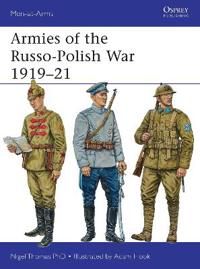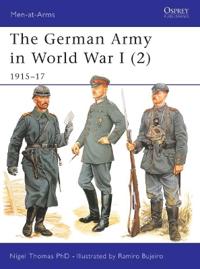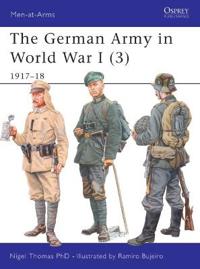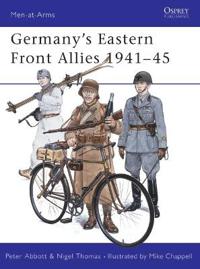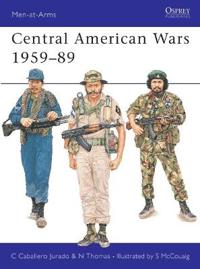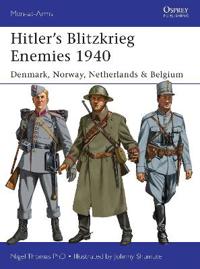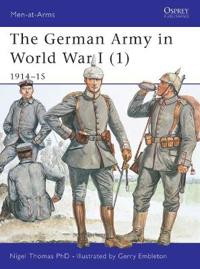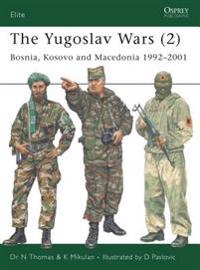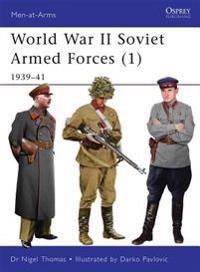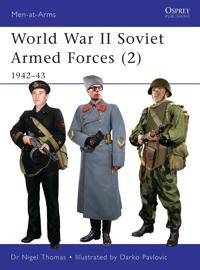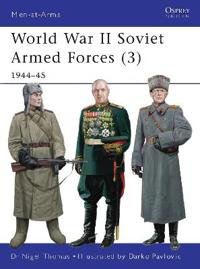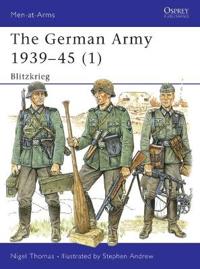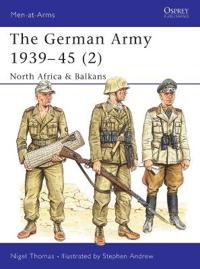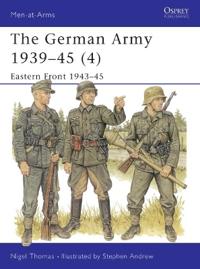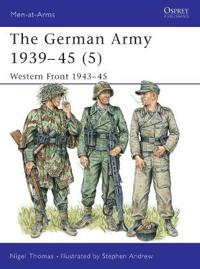Armies of the Russo-Polish War 1919-21 (Pocket)
avNigel Thomas, Adam (ILT) Hook, Nigel Thomas
ISBN: 9781472801067 - UTGIVEN: 2014-11In 1917 Poland was recognised as a state by Russia, but the Bolshevik coup threatened this. The Polish leader Marshal Pilsudski hurried to build an army around Polish World War I veterans, and in 1918 war broke out for Poland's independence, involving the Poles, the Red and White Russian armies, at [...]
The German Army in World War I, 1915-17 (Pocket)
avNigel Thomas, Ramiro (ILT) Bujeiro, Nigel Thomas
ISBN: 9781841765662 - UTGIVEN: 2004-05The years 1915-17 saw the Imperial German Army, like the other Great War combatants, forced to adapt to the new realities of static trench warfare. Prewar uniforms and equipment had to be modified, for reasons of both utility and economy; on battlefields ruled by machine guns and artillery the steel[...]
The German Army In World War I (Pocket)
avNigel Thomas, Ramiro (ILT) Bujeiro, Nigel Thomas
ISBN: 9781841765679 - UTGIVEN: 2004-12This third volume of a mini-series covering the German forces in World War I examines the troops that fought during the climax of the war on all fronts: the last great battles of attrition in the West (Arras, Messines, 3rd Ypres - Passchendaele/Langemarck - and Cambrai, 1917) and the collapse of Rus[...]
Disability, Sport and Society (Storpocket)
avNigel Thomas, Andy Smith
ISBN: 9780415378192 - UTGIVEN: 200812Disability sport is a relatively recent phenomenon, yet it is also one that, particularly in the context of social inclusion, is attracting increasing political and academic interest. The purpose of this important new text - the first of its kind - is to introduce the reader to key concepts in disab[...]
Thomas Bewick (Häftad)
avNigel Tattersfield
ISBN: 9780714126913 - UTGIVEN: 2013-05Thomas Bewick (1753-1828) was the foremost wood engraver not only of his generation, but of all subsequent generations, and the quality of his work has remained unsurpassed. His extraordinary woodcuts of animals and birds made him famous, and he dramatically influenced the development of the illustr[...]
Germany's Eastern Front Allies, 1941-45 (Häftad)
avPeter Abbott, Nigel Thomas
ISBN: 9780850454758 - UTGIVEN: 198211The 1930s were a time of growing tension for the smaller states of Eastern Europe. Since the end of the First World War they had enjoyed an independence which most of them had not known for centuries, but this was now threatened by the growing power of Nazi Germany and Soviet Russia. Instead of comb[...]
Central American Wars, 1959-1989 (Pocket)
avCarlos Caballero Jurado, Nigel Thomas, Carlos Caballero Jurado
ISBN: 9780850459456 - UTGIVEN: 1990-05Once predicted to be 'the Middle East of the Year 2000', Central America and the Caribbean have long been a powder keg of revolutionary activity and guerilla warfare. The United States, with important strategic and economic interests in the region, has traditionally opted for a military solution tow[...]
Hitler's Blitzkrieg Enemies, 1940 (Häftad)
avNigel Thomas
ISBN: 9781782005964 - UTGIVEN: 2014-02The armies of Denmark, Norway, the Netherlands and Belgium bore the first crushing impact of Hitler's mighty Blitzkrieg war machine in Western Europe, in a campaign that astonished and terrified the world. The German Wehrmacht was millions strong, equipped with the latest guns, tanks and aircraft, a[...]
Germany's Eastern Front Allies (Häftad)
avNigel Thomas
ISBN: 9781841761930 - UTGIVEN: 200201The Baltic region of Latvia, Lithuania and Estonia saw some of the most prolonged and savage fighting of any on Germany's Eastern Front during World War II. The coastal nations were invaded by the USSR in 1940; captured by the Wehrmacht in 1941; provided major recruitment for the German Army and Waf[...]
The German Army in World War I, 1914-15 (Pocket)
avNigel Thomas
ISBN: 9781841765655 - UTGIVEN: 2003-08This is the first of three books that study the German Army of World War I in great detail. They give a comprehensive study of the organisation, uniforms, insignia and equipment of the Imperial German army - in practice the combined armies of Prussia, Bavaria, Saxony and Wurttemberg. This first volu[...]
The Yugoslav Wars (Häftad)
avNigel Thomas
ISBN: 9781841769646 - UTGIVEN: 200611Following the death of the Yugoslavian strongman President Tito in 1980, the several semi-autonomous republics and provinces that he had welded into a nation in 1945 moved inexorably towards separation. As the world watched a series of wars ripped through this modern European state. In this second o[...]
The Hungarian Army in World War II (Häftad)
avNigel Thomas
ISBN: 9781846033247 - UTGIVEN: 200810The Royal Hungarian Army was Germany's largest ally on the Eastern Front during World War II (1939-1945), providing a vital contribution in terms of both men and equipment. Information about the Hungarian Army in English is rare, and in this book co-authors Nigel Thomas and Hungarian expert Laszlo S[...]
World War II Soviet Armed Forces (Häftad)
avNigel Thomas
ISBN: 9781849084000 - UTGIVEN: 201010This would be a detailed analysis of the Soviet Army at the outbreak of World War II, including the Red Army's campaigns against Japan on the Manchurian plains as well as in Finland. It would also cover the Red Army's first operations during Operation Barbarossa when the Red Army was forced to defen[...]
World War II Soviet Armed Forces (Häftad)
avNigel Thomas
ISBN: 9781849084208 - UTGIVEN: 201107In this second volume of a three-part series on the Soviet Armed Forces in World War II, author Nigel Thomas turns his attention to the mid-war period. Focusing on the uniforms and organization of Soviet troops during the campaigns of the Caucasus, Stalingrad and Kursk, this book offers a detailed b[...]
World War II Soviet Armed Forces (Häftad)
avNigel Thomas
ISBN: 9781849086349 - UTGIVEN: 201211This book presents a detailed analysis of the Soviet armed forces during the final days of the war, covering the soldiers that successfully turned the tide against the Nazi onslaught and pushed it back into Germany itself. This final part of the series documents the Red Army's push through Germany t[...]
The German Army, 1939-45 (Häftad)
avNigel Thomas, Stephen Andrew
ISBN: 9781855326392 - UTGIVEN: 199711The first of a series of five books on the German army of World War II. This volume focuses on their achievements from 1935 to 1940, and how the military traditions of Germany were used by Hitler to dominate Europe. Nigel Thomas examines the ways in which this army was trained and organized to allow[...]
German Army, 1939-45 (Häftad)
avNigel Thomas
ISBN: 9781855326408 - UTGIVEN: 199804Hitler first considered an invasion of Great Britain in autumn 1940, then scheduled Operation Barbarossa, the conquest of the European part of the Soviet Union, for May 1941. Anxious to emulate Hitler's successes, the Italian dictator Mussolini embarked upon unnecessary military adventures in North [...]
The German Army, 1939-45 (Häftad)
avNigel Thomas
ISBN: 9781855327962 - UTGIVEN: 199907In early 1943, the annihilation of the 6th Army at Stalingrad marked the irreversible turning-point of World War II (1939-1945) in the East. Despite occasional local successes gained in the face of great odds - testimony to the Wehrmacht's extraordinary resilience - from now on Germany was on the de[...]
The German Army, 1939-45 (Häftad)
avNigel Thomas
ISBN: 9781855327979 - UTGIVEN: 200001This book covers the high command, the developments in unit organisation, the campaigns and the uniforms and equipment of the German Army in the last two years of the war in North-West Europe and Italy. Despite the huge pressure of fighting on three fronts, ever-worsening shortages of manpower and e[...]
Children, Family and the State (Häftad)
avNigel Thomas, Malcolm Hill
ISBN: 9781861344489 - UTGIVEN: 2002-10What part should children take in decisions about their lives? Does their need to be involved in decisions conflict with adult responsibility for their welfare? In its search for answers to these questions, "Children, Family and the State" examines different theories of childhood, children's rights [...]
Leading with Safety, 2nd Edition (Inbunden)
avThomas R. Krause, Rebecca Nigel
ISBN: 9780470642108 - UTGIVEN: 2013-01-31Leading with Safety defines the practices, tools, and systems essential to creating an injury-free workplace, including the role of employees at each level, special considerations for coaching the senior executive leader, and the two crucial aspects of human performance that every leader needs to kn[...]
Children, Politics and Communication (Pocket)
avNigel (EDT) Thomas
ISBN: 9781847421838 - UTGIVEN: 2009-05Even after 20 years of children's rights and new thinking about childhood, children are still frequently seen as apolitical. All over the world there has been a growing emphasis on 'participation', but much of this is adult-led, and spaces for children's individual and collective autonomy are restri[...]

